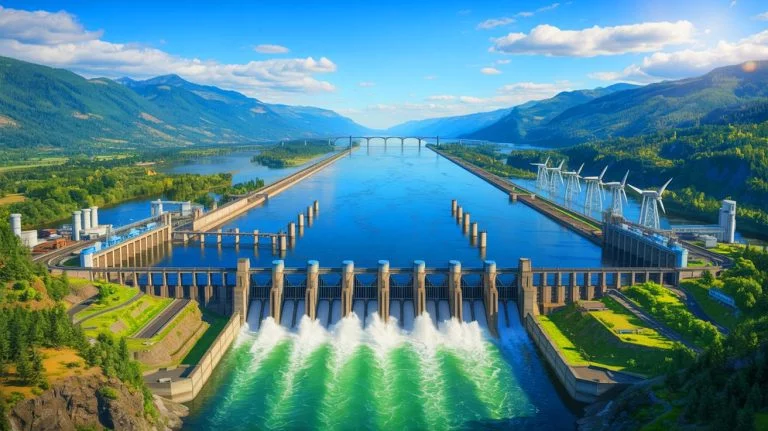| IN A NUTSHELL |
|
Amidst the serene flow of the Columbia River, a pivotal transformation is underway. This river, a symbol of natural beauty and an essential resource, is now the focal point of a high-stakes energy debate between the United States and Canada. As the demand for clean energy surges and climate concerns intensify, the longstanding Columbia River Treaty is under scrutiny. The outcome of these negotiations will not only influence energy production but could also redefine cross-border relations and environmental stewardship.
The American Energy Race Has Gained New Momentum
The Columbia River stands as a monumental force in the American energy landscape. It generates an impressive 40% of the US’s hydroelectric power and facilitates the transport of 42 million tons of cargo annually. Additionally, its waters support agricultural activities with over US$8 billion in irrigation. This remarkable river has been managed through a treaty between the United States and Canada since 1964, focusing on several critical areas: energy, flood control, water for irrigation, and migratory fish. However, as the original treaty ages, the evolving energy demands and climate unpredictability necessitate a thorough update.
Recent years have highlighted the urgency of rethinking this agreement. The push for renewable energy sources has accelerated, and the need for sustainable management of shared water resources has become more pressing. The Columbia River Treaty, once a model of international cooperation, now requires modern solutions that address both nations’ energy needs while considering ecological impacts. The stakes are high, and the decisions made today will resonate for generations.
“World’s first-ever”: Denmark’s historic tax on cow farts shocks climate activists worldwide
And Here Comes the Surprise: It’s Generating Tension on the Other Side of the Border
Recently, a preliminary agreement to update the Columbia River Treaty was announced by US President Joe Biden and Canadian Prime Minister Justin Trudeau. Although it appeared as a diplomatic success, the details sparked considerable concern across Canada and among environmental advocates. The revised terms propose a significant reduction in energy transferred from the US to Canada—37% initially, escalating to 50% by 2033. In return, the US retains the ability to utilize Canadian reservoirs for flood control, accompanied by a compensatory payment of $37.6 million over two decades.
This announcement has intensified scrutiny from various stakeholders, as the proposed changes may disrupt the delicate balance of shared resources. The reduction in energy benefits for Canada raises questions about the equitable distribution of the river’s bounty. Furthermore, environmentalists worry about the potential ecological consequences, emphasizing the need for a more sustainable approach that prioritizes both economic and environmental considerations.
Between Turbines and Fish, Who Gets the Water?
The renegotiation of the Columbia River Treaty has sparked a renewed debate about the river’s primary purpose. Is it an open-air power plant, a flood regulator, or a nature sanctuary? While policymakers focus on energy efficiency, Indigenous communities and environmental groups advocate for the protection of salmon populations. These fish, already challenged by dams and habitat loss, now face additional threats due to shifting priorities.
Although the updated treaty includes provisions for a joint committee with tribal representation to address environmental concerns, many critics argue that this is insufficient. They view it as a modest gesture that fails to address the broader ecological crisis. Activists call for a more comprehensive approach that acknowledges the river’s ecological significance and ensures the survival of key species. The Columbia River’s future must balance energy production with ecological preservation to maintain its role as a vital natural asset.
What Now? Where Does This Political River Flow?
The Columbia River’s history teaches us that change is inevitable, whether driven by natural forces or human intervention. The push for renewable energy is accelerating, as the US seeks clean power sources for electric vehicles, data centers, and urban areas. Yet, adjusting the intricate water management systems without considering all voices risks creating new challenges. Water may transcend borders, but treaties define them.
The proposed agreement awaits approval from the US Senate, but its implications are already evident. The energy race, once seen as a victory for sustainability, now poses diplomatic challenges. As the US and Canada navigate this complex landscape, the question remains: can they collaborate to forge a new, equitable deal that satisfies energy needs and environmental responsibilities? How will these negotiations shape the future of international cooperation in the pursuit of sustainable solutions?
Did you like it? 4.5/5 (25)








Wow, 40% of the US’s hydroelectric power from one river? That’s insane! 🌊⚡
Why reduce the energy transfer to Canada by 37%? Seems unfair to our neighbors. 🤔
As always, it’s the fish that suffer when humans want more energy. Poor salmon! 🐟
Thank you for shedding light on such a complex issue. It’s important to keep informed. 👍
Can someone explain why the US needs control over Canadian reservoirs for flood control? 🤷♀️
I hope the Senate considers the environmental impact before approving this treaty.
Interesting article, but I doubt the US and Canada will find a solution that satisfies everyone.
More power to the power plants! Let’s harness the full potential of the Columbia River. 🔋
What about the indigenous communities? Are their concerns being addressed in this treaty?
Why is the US paying only $37.6 million over two decades? Seems like pocket change.